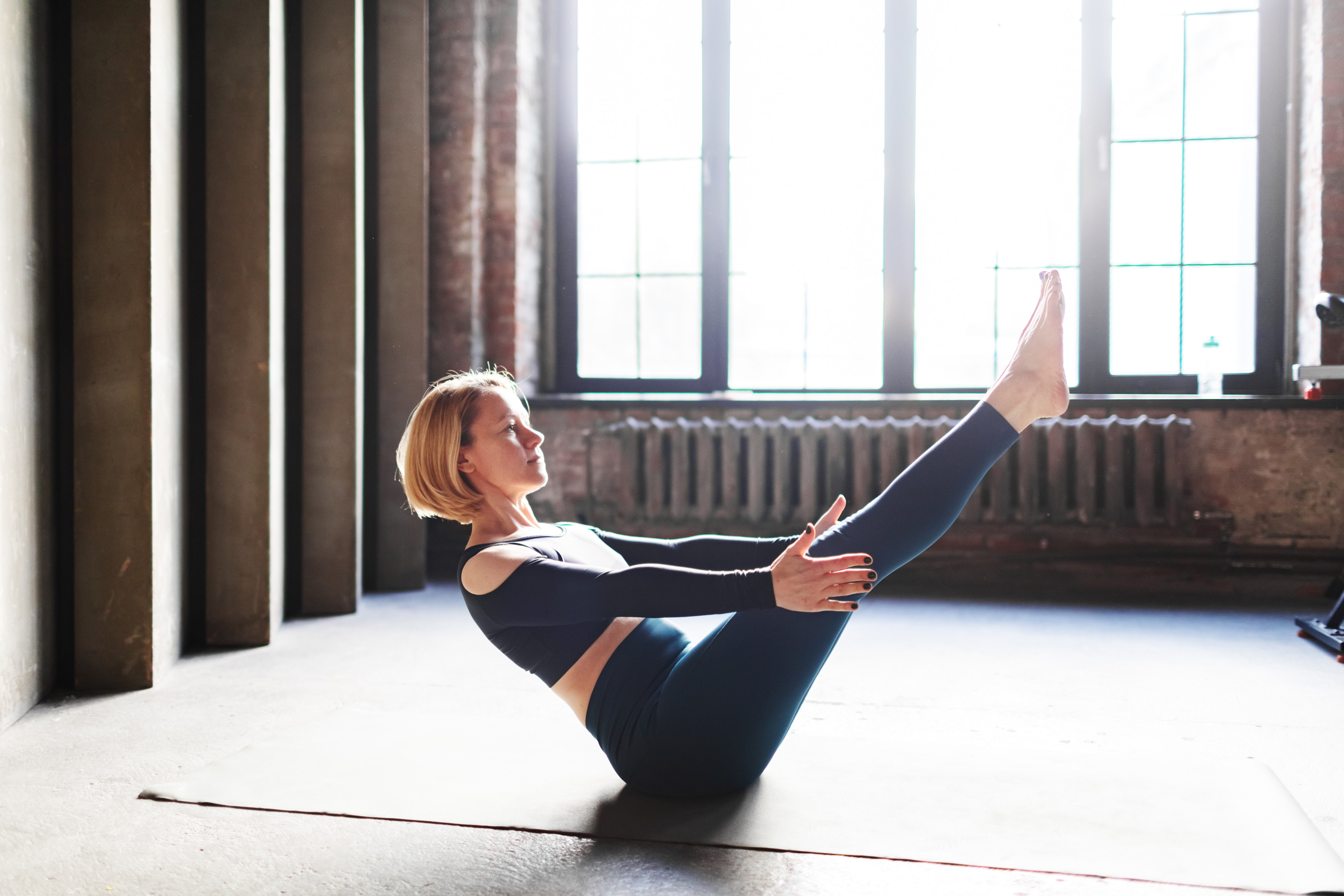
JulPo/Getty Images
How to Practice Boat Pose, According to Yoga Experts
Hint: You don't need perfect balance to properly do this seated posture.
By Jenny McCoy•
What Is Boat Pose (Paripurna Navasana)?
What Muscles Does Boat Pose Work?
What Are the Benefits of Boat Pose?
How to Properly Do Full Boat Pose
Boat Pose Variations and Adjustments
Boat Pose Mistakes to Avoid
Is Boat Pose Safe to Practice During Pregnancy?
Practice: Try a Yoga Sequence with Boat Pose
If we had to describe Boat Pose in two words, we’d go with “surprisingly effective.” Known as Paripurna Navasana in Sanskrit, this classic yoga posture may look simple, but it builds serious core strength while also engaging your legs, hip flexors, back, shoulders, and arms. “It really is a full body pose,” says Peloton yoga instructor Anna Greenberg. “Practicing it is a great way to improve body awareness, increase focus, and improve your posture.”
If you’re interested in learning how to do Boat Pose (or improving your form), you’ve come to the right place. We tapped Anna and other yoga experts to break down everything you need to know about this foundational posture, including the muscles it works, modifications for all levels, and common form mistakes to avoid.
What Is Boat Pose (Paripurna Navasana)?
Boat Pose (Paripurna Navasana) is a seated yoga posture that involves balancing on your sitting bones as you raise your legs straight up and reach your arms forward. When you're in a full expression of Boat Pose, your body somewhat resembles an upside down capital “A” or, as the posture’s name suggests, a boat.
Boat Pose is commonly used in vinyasa classes, a fast-paced style of yoga that links together movements and breathing patterns, and power yoga classes, which are centered on improving strength and endurance, according to Tara Salay, a New York-based physical therapist and certified yoga instructor. Because Boat Pose is a static posture, it’s typically followed by a sequence designed to get your body moving, she says.
Even if you’ve never practiced yoga, you might’ve tried a Boat Pose variation as part of other types of workouts. For example, you could’ve done V-sit holds during a strength training session or hundreds during a Pilates class.
What Muscles Does Boat Pose Work?
You work the following muscles while practicing Boat Pose:
Hip flexors. You engage this group of muscles, which is situated at the top of your thighs, when you fully extend your legs.
Core muscles, including your rectus abdominis (the muscle in the center of your body that helps you bend and straighten), transverse abdominis (a deep stabilizing muscle), obliques (the muscles on the sides of your torso), and back. To really activate your core in Boat Pose, “focus on keeping your lower spine straight instead of allowing it to curve,” says Jessica Klain, a Denver-based physical therapist and founder of Physio Yoga & Wellness.
Shoulders and arms, which activate as you reach forward. To put more of an emphasis on your upper body, practice Boat Pose with a strap. This variation requires your arms to work harder to hold your legs up in the air, Klain says. Find further instructions on how to do this variation below.
Legs, including your quads and shins, which really fire up if you flex your toes in Boat Pose. Actively pulling back your feet like this is optional, but it can bring more stability to the posture by increasing muscle activation, Klain explains.
What Are the Benefits of Boat Pose?
Boat Pose isn’t just an intense muscle burner; the benefits of practicing this posture can extend to your mind, motor system, and more. Some of the main ones include:
Better body awareness. Because Boat Pose involves balancing on your sitting bones, which requires you to make small adjustments by shifting your weight, it can be a great way to improve proprioception, or knowledge of where your body is in space, Klain says. Proprioception is also important for learning new motor skills and preventing injuries.
Deep core strength. Boat Pose helps strengthen and stabilize your deep core muscles, which can offer a ton of benefits, such as alleviating chronic low back pain.
Sharpened focus and posture. “In order to hold Boat Pose correctly, you have to integrate your body and figure out how everything connects,” Anna says. It's a great way to promote focus, work on your breathing, and improve posture—all at the same time.
How to Properly Do Full Boat Pose
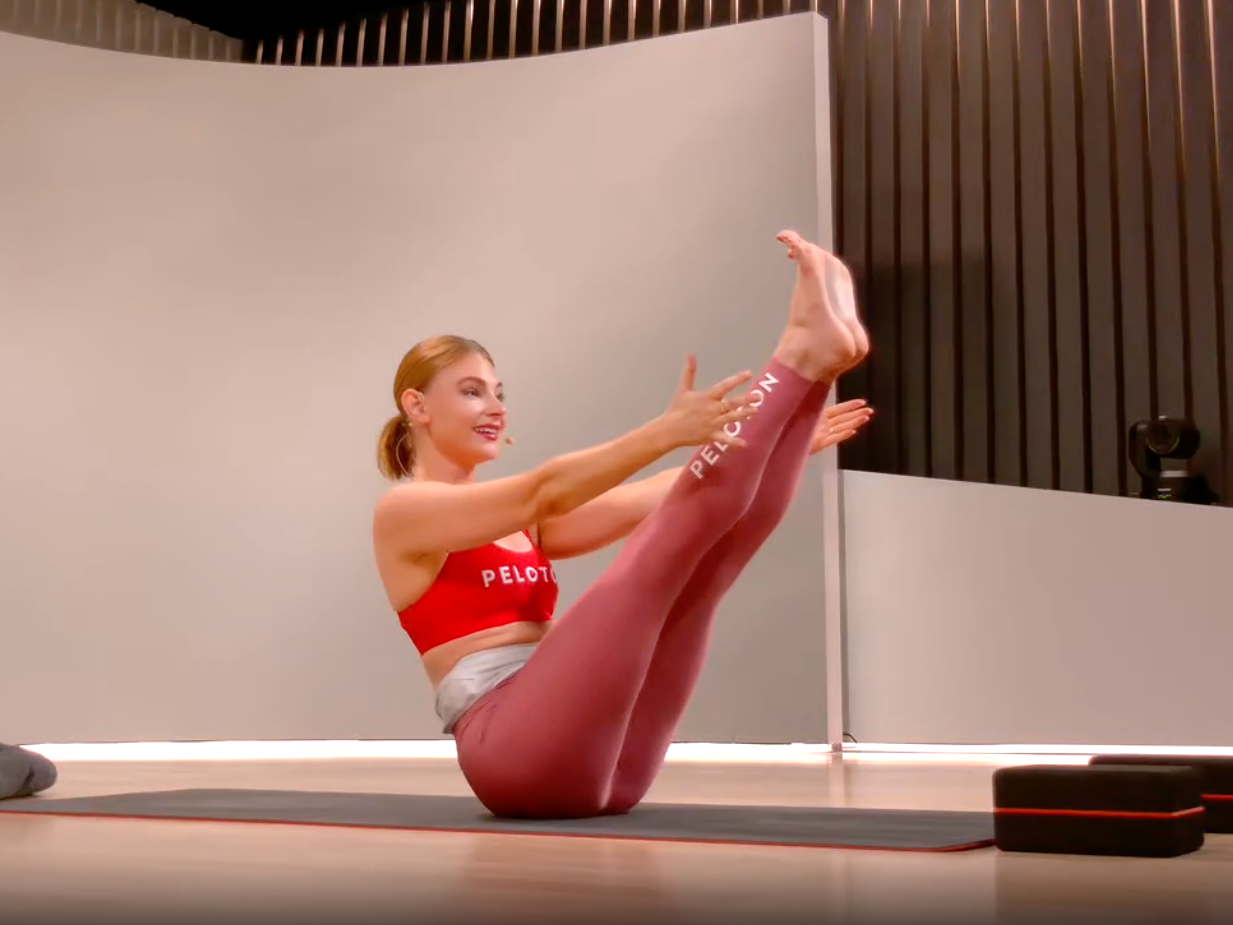
Learn how to properly practice Boat Pose by following these step-by-step instructions:
Sit on your yoga mat with your spine straight and your hands resting on the ground by your hips. Bend your knees and plant your feet on the floor. Keep your spine straight as you lean back slightly.
Lift your feet up, keeping your knees bent as you balance on your sitting bones.
Once you feel stable, reach your arms forward with your palms facing each other and straighten your legs. Continue engaging your core by pulling your belly button up and in toward your spine. Make sure to keep your breath steady.
Hold this position for the duration of three breaths. Once you become more comfortable, gradually progress to holding it for the duration of five.
Expert tip: If you can’t do a full expression of Boat Pose (or it just doesn’t feel good for your body), it might not be because of a lack of strength. Anna says that “oftentimes the biggest restrictor to doing Boat Pose properly is tight hamstrings,” which can cause your back to round and throw you off balance as you straighten your legs. If that’s happening to you, keep your knees bent to lower the risk for injury while still reaping benefits from the posture.
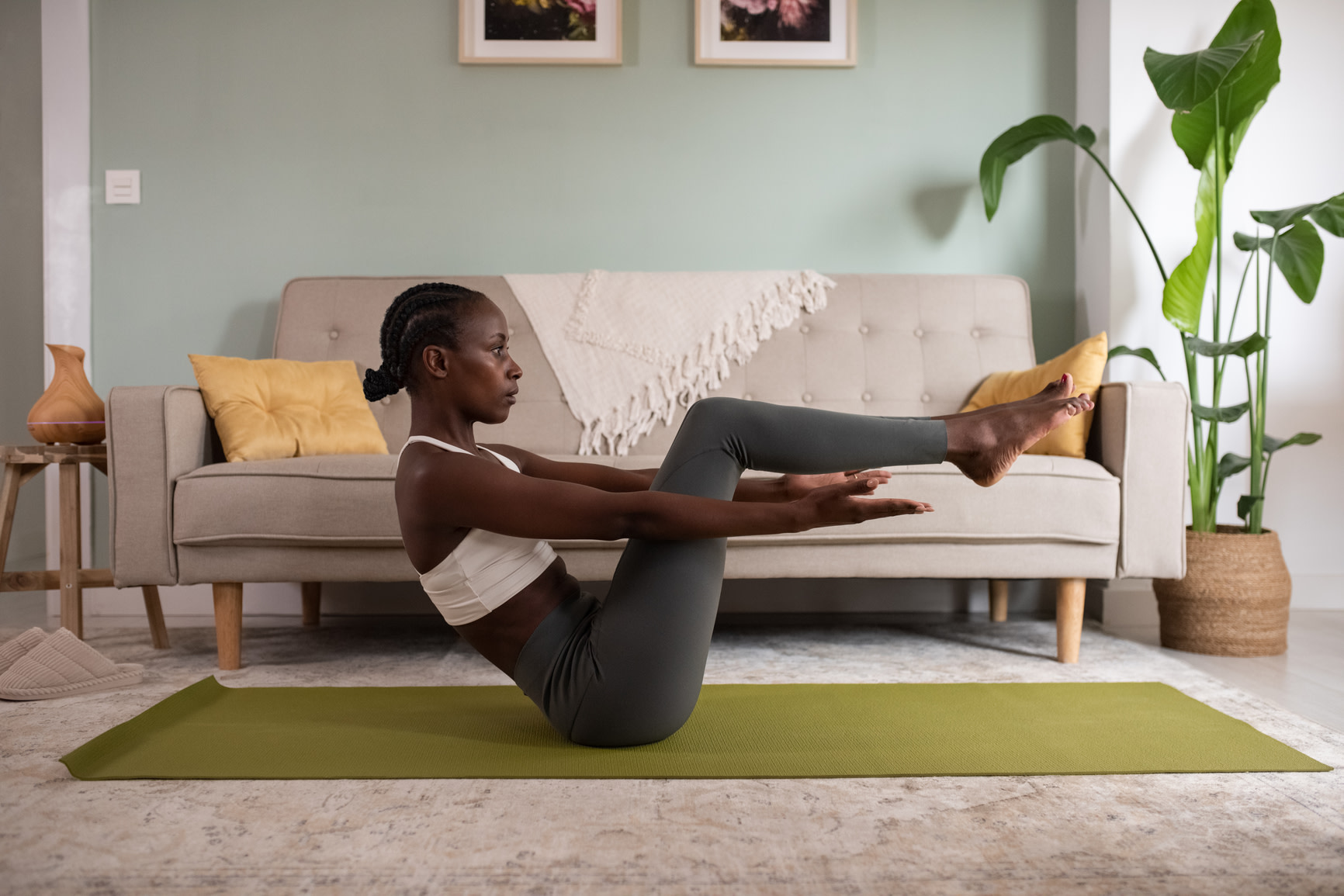
Milles Studio/Stocksy
Boat Pose Variations and Adjustments
There are many ways to modify Boat Pose to make it easier, harder, or more interesting. Consider one of the following three variations, which range from beginner-friendly to advanced.
Beginner: Half Boat Pose
Boat Pose is challenging, even for advanced yoga practitioners, so there’s a good chance you’ll need to modify it as you focus on building up your strength. One option is to rest your heels on the ground in a variation called Half Boat Pose. “You can also raise your heels in the air but hold onto the backs of your thighs for support,” Klain says.
Intermediate: Boat Pose with a Strap
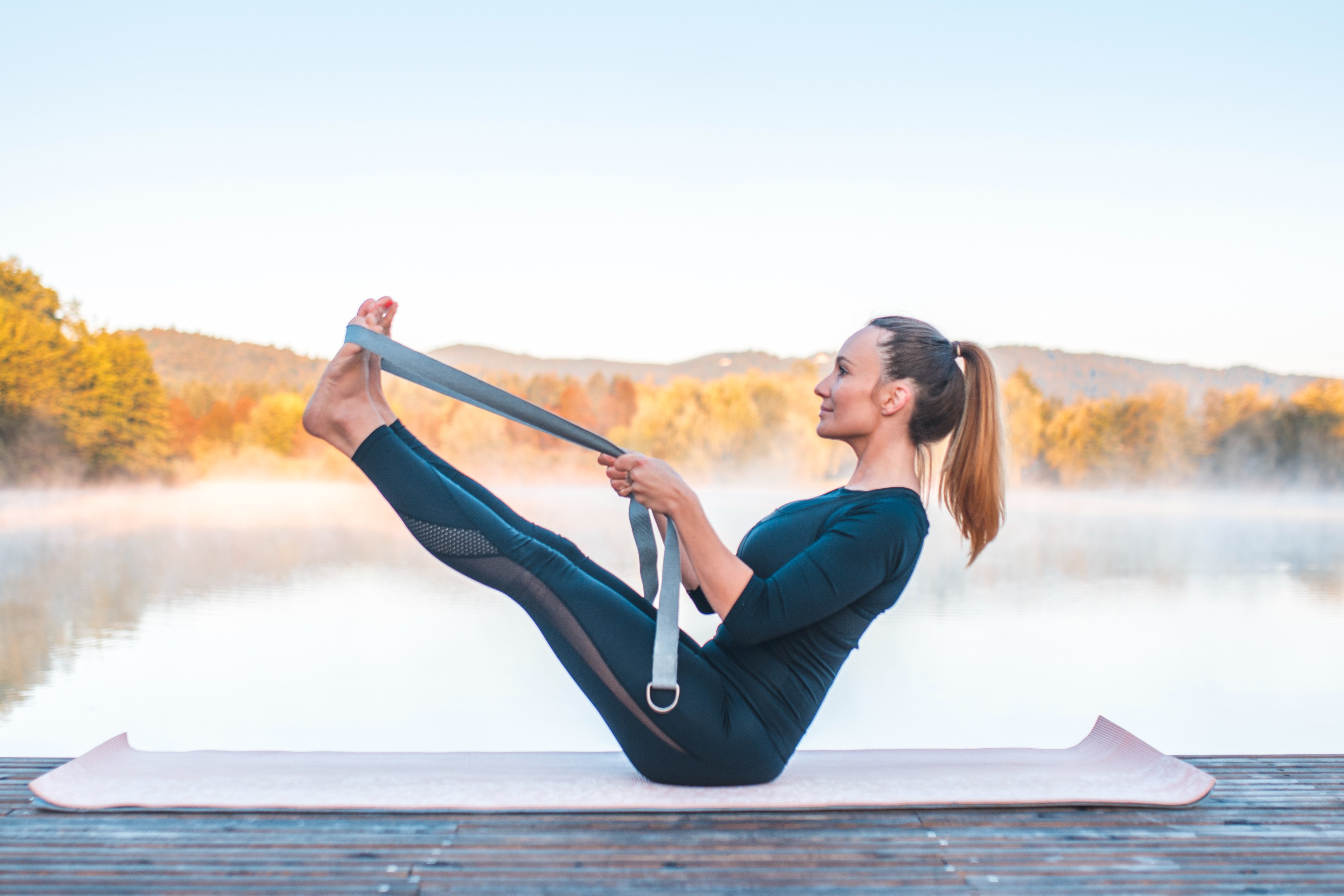
AzmanL/Getty Images
Performing Boat Pose with a strap places a stronger emphasis on your arms since they have to work extra hard to hold up your legs. This version is also more of a balance challenge since you’re relying less on the strength of your hip flexors to stay in the pose, Klain says.
To do it, place the strap (or a towel) around the soles of your feet. Hold the ends firmly in each hand and assume Boat Pose from there.
Advanced: Boat Pose with Oblique Twist
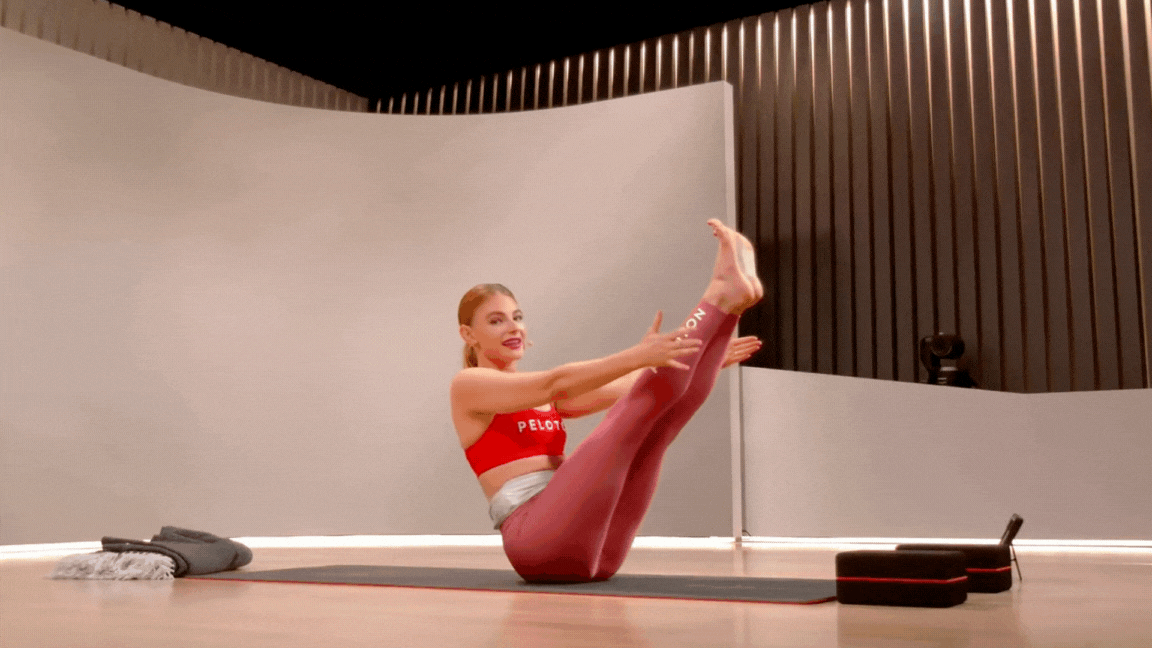
For a balance challenge that incorporates your obliques, try Boat Pose with a twist. Here’s how to do it:
From Boat Pose, inhale and lift both of your arms overhead, then exhale and twist your torso to the right.
Open your chest to that side of the room as your right arm points behind you and your left arm points in front of you. Alternatively, you can keep your hands pressed together in a prayer position. Stay tall through your spine and avoid arching or rounding your low back.
Inhale as you return to center, reaching your arms overhead. For an added challenge, do a hollow hold between sides.
Exhale as you twist and repeat the above movements on the left side.
Alternate sides for several reps.
Boat Pose Mistakes to Avoid
Boat Pose isn’t an overly complicated exercise, but it’s still possible to make errors that can decrease the move’s effectiveness and leave you vulnerable to injury. Below, experts share the most common mistakes they see people make.
Flexing or rounding your spine. If your spine isn’t straight in Boat Pose, it’s usually a sign that you aren’t properly engaging your core muscles, and it can even lead you to strain your back. Counteract this error by focusing on lifting your chest and staying “tall through the spine and straight through the low back,” Klain says.
Shrugging your shoulders. People tend to raise and tense their shoulders when they’re working hard to hold Boat Pose. That’s a no-go because it engages your upper trap muscles, which isn’t the point of the exercise, Salay says. Relax your shoulders down and away from your ears. If you find yourself getting fatigued, put your feet down or hold onto your knees for a breath before coming back into the pose. Sometimes taking a brief pause can help your muscles reset and allow you to find proper positioning.
Holding your breath. Breathing is an essential part of yoga, but it can easily lapse if you’re working hard or getting tired in a pose, Klain says. Make sure to steadily inhale and exhale from the time you enter into Boat Pose to get the maximum amount of benefits from the posture.
Sacrificing form to do the full expression of the pose. “You can get great benefits from Boat Pose by tailoring it to meet you where you are,” Anna says. But don’t force the traditional pose if it’s just not working for you. “It’s more important to maintain a long spine and lifted chest than to have your legs straight,” Anna says.
Tolerating tailbone pain. Some people experience pain around in their tailbone area while practicing Boat Pose, which is likely due to the anatomy of their sitting bones. If that happens to you, try sitting on a softer surface, like a thicker mat or a yoga blanket. Remember: This posture should be challenging, not painful.
Is Boat Pose Safe to Practice During Pregnancy?
It depends (and you should always check with a doctor before doing any exercise while pregnant). Boat Pose can put a lot of pressure on the abdomen and lead to coning, or bulging in the middle of your stomach, which can then contribute to diastasis recti, the separation of the abdominal muscles that happens during and after pregnancy, Anna says. However, this doesn’t happen to everyone.
If you do Boat Pose correctly with proper spine and rib alignment, your core will fully activate and stress to the abdominal muscles should be minimal, Klain says. The key is to tune into your body. If you notice any coning or doming of your belly, that means Boat Pose is too challenging for your current strength level and you should take a modification, Klain says.
If Boat Pose feels good but your pregnant belly is getting in the way, try moving your knees out wider and bringing your toes and heels together. These small changes will place more focus on your hip abductor muscles rather than your hip flexors, Klain says.
Practice: Try a Yoga Sequence with Boat Pose
Practicing Boat Pose on its own is a great way to perfect your form and build core strength, but doing it as part of a sequence can challenge your body and mind in new ways. Peloton App users can choose from a huge selection of beginner-friendly yoga classes to meet your needs. These three are a great place to start:
This content is for informational and educational purposes only and does not constitute individualized advice. It is not intended to replace professional medical evaluation, diagnosis, or treatment. Seek the advice of your physician for questions you may have regarding your health or a medical condition. If you are having a medical emergency, call your physician or 911 immediately.
Want to strengthen your yoga practice?
We can help. Enter your email to get articles, instructor tips, and updates from Peloton sent to your inbox.
By providing your email address, you agree to receive marketing communications from Peloton.
For more about how we use your information, see our Privacy Policy.





